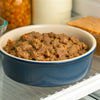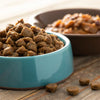How Much Wet Food Should a Dog Eat a Day? A Comprehensive Guide for Pet Owners
- Houndsy
Table of Contents
- Introduction
- The Importance of Proper Feeding for Dogs
- Understanding Feeding Guidelines for Canned Dog Food
- Calculating the Right Amount of Canned Food Based on Your Dog's Weight
- Considerations for Mixing Canned and Dry Food
- Adjusting Feeding Based on Life Stages and Health Needs
- Conclusion
Introduction
Did you know that nearly 59% of dogs in the United States are classified as overweight or obese? This startling figure underlines the significance of understanding proper feeding habits for our canine companions. As responsible pet owners, we're faced with the challenge of navigating our pets' dietary needs, especially when it comes to wet dog food. Not knowing how much wet food to feed your dog daily can lead to serious health issues, including obesity, malnutrition, and a shorter lifespan.
In this blog post, we will explore how much wet food should a dog eat a day, emphasizing the importance of appropriate portion control to ensure our furry friends receive the best nutrition for their specific age, weight, and activity levels. By the time you finish reading, you’ll possess a thorough understanding of how to accurately gauge wet food portions, providing your dog with a balanced and healthy diet without the risk of overfeeding.
We’ll dive into the following topics:
- Understanding the importance of proper feeding
- The standard feeding guidelines for canned dog food
- Methods for calculating the appropriate amount of wet food based on your dog’s specific characteristics
- Insights into mixing wet and dry food effectively
- Adjusting feeding practices based on life stages and health considerations
So, let’s embark on this journey to ensure our beloved pets lead healthy and fulfilling lives!
The Importance of Proper Feeding for Dogs
Feeding isn't solely about filling a bowl; it's a crucial determinant of your dog’s overall health. The importance of proper feeding cannot be overstated:
-
Obesity Risks: Overfeeding can lead to obesity, which, in turn, is linked to serious health problems such as joint complications, diabetes, and heart disease.
-
Nutrition Deficiencies: Conversely, underfeeding can result in nutritional deficiencies that impede your dog's energy levels, immune function, and overall well-being.
-
Longevity: Providing balanced nutrition tailored to your dog's needs is pivotal for a longer, healthier life.
At Houndsy, we understand these challenges and are dedicated to simplifying the pet feeding experience. That’s why we’ve created our Houndsy Kibble Dispenser—not just to serve food, but to serve it accurately and beautifully.
Understanding Feeding Guidelines for Canned Dog Food
The feeding guidelines for wet dog food can be somewhat perplexing, as they vary by brand and specific formulation. Generally, manufacturers will provide feeding recommendations based on a dog’s weight, but it’s essential to recognize that caloric density significantly impacts these figures.
General Feeding Recommendations
Here’s a guideline to visualize how much wet food to provide based on your dog’s weight:
- Under 10 pounds: 1/4 to 1/2 can per day
- 10 to 20 pounds: 1/2 to 1 can per day
- 20 to 40 pounds: 1 to 1.5 cans per day
- 40 to 60 pounds: 1.5 to 2 cans per day
- 60 to 80 pounds: 2 to 2.5 cans per day
- 80 to 100 pounds: 2.5 to 3 cans per day
These recommendations serve as a general guideline. Your dog’s specific dietary needs may vary due to age, activity level, and health condition, underlining the need for tailored feeding practices.
Calculating the Right Amount of Canned Food Based on Your Dog's Weight
To accurately determine how much canned food your dog should eat, you’ll need to take into account their ideal weight, preferably considering advice from your veterinarian.
Steps to Calculate Proper Food Portions:
-
Determine Your Dog’s Ideal Weight: Your vet can help you establish an ideal weight based on breed and current health status.
-
Consult Feeding Guidelines: Review the feeding recommendations on the wet food label based on your dog’s weight.
-
Calculate Daily Portions: If, for instance, your dog weighs 30 pounds and the recommendation states 1 can per 15 pounds, then they should get 2 cans per day.
-
Divide Into Meals: If you're feeding your dog twice daily, simply divide the total amount by the number of meals. In this case, if your dog requires 2 cans, serve 1 can per meal.
-
Monitor and Adjust: Continually observe your dog’s weight and general health. If there are unexpected changes, consult your vet for necessary adjustments.
Example Calculation
Let’s say you have a 50-pound dog. According to the guidelines, they require about 1.5 to 2 cans per day. If we opt for an average of 1.75 cans, divide this into two meals, providing approximately 0.875 cans per meal, which is roughly 7/8 can. This method ensures a consistent feeding routine that aligns with their nutritional needs.
Considerations for Mixing Canned and Dry Food
Mixing wet and dry dog food can offer a variety of benefits—from increased palatability to enhanced hydration and a broader spectrum of nutrients. However, it's essential to balance the ratios carefully to avoid overfeeding.
Guidelines for Mixing Wet and Dry Food
-
Adjust Portions: When adding wet food, reduce the dry food portion. As a rule, for every half can of wet food, you may want to subtract about 1/3 cup of dry food.
-
Monitor Caloric Intake: Ensure that the combined caloric intake remains appropriate to prevent weight gain.
-
Experiment with Ratios: Each dog has unique preferences, so adjusting the wet-to-dry food ratio can help find what they enjoy most while adhering to nutritional guidelines.
Benefits of Mixing
-
Increased Palatability: Canned food can entice picky eaters.
-
Enhanced Hydration: Wet food provides additional moisture, important for your dog’s hydration.
-
Nutritional Variety: Mixing food types enriches your dog’s diet, ensuring they receive a full spectrum of nutrients.
Adjusting Feeding Based on Life Stages and Health Needs
It's crucial to remember that a dog's nutritional requirements evolve as they move through different life stages. Puppies, adult dogs, and senior dogs all have varying needs that should inform how much wet food to serve.
Feeding Puppies
Puppies typically require higher calorie intake for growth. Depending on their age, you may need to offer 2-4 times the amount of food compared to adults, focusing on specialized puppy formulas.
Feeding Adult Dogs
Adult dogs should have their meals tailored to maintain their energy levels. Active dogs may need more than sedentary ones, requiring frequent monitoring and adjustments according to their activity levels.
Feeding Senior Dogs
As dogs age, their caloric requirements often decrease. It's vital to offer senior formulas that usually feature lower caloric content with added joint-supporting nutrients. Regular monitoring is essential to adjust food portions based on their health status.
Conclusion
Understanding how much wet food to feed your dog is an eternally relevant topic, directly linked to their health and quality of life. By adhering to proper feeding guidelines and adjusting portions based on your dog’s unique needs, you can help them maintain optimal health and keep obesity at bay.
At Houndsy, we believe that feeding your dog should be a pleasurable and simple experience. Our innovative Houndsy Kibble Dispenser is here to assist in creating perfect portion control with style, helping you transform your dog feeding routine into something beautiful and manageable.
Are you ready to enhance your dog feeding experience? Don’t forget to check out the Houndsy Kibble Dispenser today and see how we can simplify your pet care journey! Order Now.
FAQ
-
How do I know how much wet food to feed my dog?Start by checking the feeding guidelines on the wet food label based on your dog's weight. Adjust for their activity level and consult your vet for personalized recommendations.
-
Can I mix canned food with dry food?Yes! Mixing canned food with dry options can enhance palatability and provide additional hydration. Just ensure to adjust portions to prevent overfeeding.
-
How many meals should I feed my dog each day?Most adult dogs thrive on two meals per day. Puppies may require more frequent feeding, and senior dogs may also benefit from a tailored schedule.
-
What if my dog is overweight?Consult your veterinarian to develop a weight management plan that includes appropriate feeding amounts and exercise.
-
Are there any specific dietary needs for senior dogs?Senior dogs benefit from lower-calorie diets and foods enriched with joint-supporting nutrients. Always consult your veterinarian for individualized dietary recommendations.












